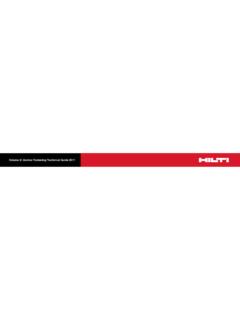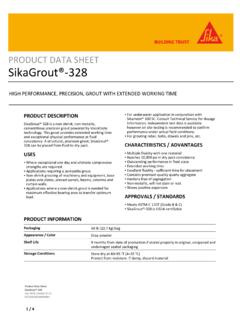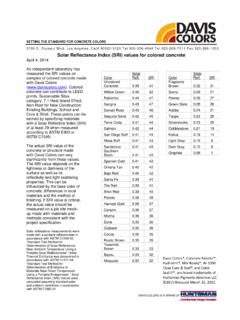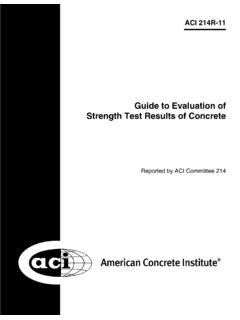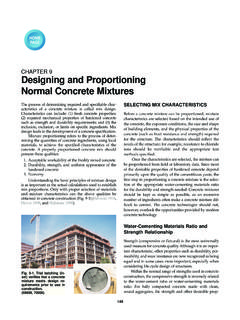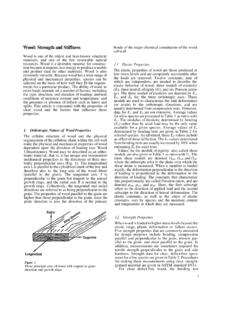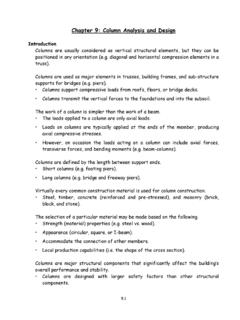Transcription of Simpson Strong-Tie SET-XP High-Strength Epoxy Adhesive
1 C-A-2018 2018 Simpson Strong-Tie COMPANY AnchorsSimpson Strong-Tie Anchoring, Fastening and Restoration Systems for Concrete and MasonrySET-XP High-Strength Epoxy AdhesiveTest Criteria Anchors installed with SET-XP Adhesive have been tested in accordance with ICC-ES Acceptance Criteria for Post-Installed Adhesive Anchors in Masonry Elements (AC58) and Adhesive Anchors in Concrete Elements (AC308).PropertyTest MethodResult*ConsistencyASTM C881 Passed, non-sagGlass transition temperatureASTM E1356155 FBond strength (moist cure)ASTM C8822,916 psi at 2 daysWater absorption ASTM yield strengthASTM D69514,110 psiCompressive modulusASTM D695612,970 psiShore D DurometerASTM D224084 Gel timeASTM C88160 minutesVolatile Organic Compound (VOC) 3 g/L*Material and curing conditions: 73 2 F, unless otherwise Cartridge SystemModel (ounces)Cartridge TypeCarton QuantityDispensing Tool(s)Mixing , EDTA22P, EDTA22 CKTSET-XP22-N522 Side-by-Side10 EDT22S, EDTA22P, EDTA22 CKTSET-XP5656 Side-by-Side6 EDTA56P1.
2 Cartridge estimation guidelines are available at Detailed information on dispensing tools, mixing nozzles and other Adhesive accessories is available at Use only Simpson Strong-Tie mixing nozzles in accordance with Simpson Strong-Tie instructions. Modification or improper use of mixing nozzle may impair SET-XP Adhesive Two EMN22I mixing nozzles and two nozzle extensions are supplied with each One EMN22I mixing nozzle and one nozzle extension are supplied with each ScheduleBase Material TemperatureGel Time (minutes)Cure Time (hrs.) F C501075726016604870214524903235241104320 24 For water-saturated concrete, the cure times must be 2018 Simpson Strong-Tie COMPANY AnchorsSDSimpson Strong-Tie Anchoring, Fastening and Restoration Systems for Concrete and Masonry* See p. 13 for an explanation of the load table icons. SET-XP Design Information ConcreteIBC* SET-XP Installation Information and Additional Data for Threaded Rod and Rebar in Normal-Weight Concrete1 CharacteristicSymbolUnitsNominal Anchor Diameter (in.)
3 / Rebar Size 3/8 / #31/2 / #45/8 / #53/4 / #67/8 / #71 / #81 1/4 / #10 Installation InformationDrill Bit 2 5 8 3 4 7 8 11 1 81 3/8 Maximum Tightening Torque Embedment Depth 3/82 3 43 1 83 1 23 3 1 21012 1 21517 1 22025 Minimum Concrete + 5dholeCritical Edge footnote 2 Minimum Edge 3 42 3 4 Minimum Anchor The information presented in this table is to be used in conjunction with the design criteria of ACI 318-14 and ACI cac = hef ( k,uncr/1,160) x [ (h/hef)], where: [h/hef] k,uncr = the characteristic bond strength in uncracked concrete, given in the tables that follow kuncr ((hef x f'c) ( x dhole)) h = the member thickness (inches) hef = the embedment depth (inches)C-A-2018 2018 Simpson Strong-Tie COMPANY AnchorsSDSimpson Strong-Tie Anchoring, Fastening and Restoration Systems for Concrete and Masonry* See p.
4 13 for an explanation of the load table icons. SET-XP Tension strength Design Data for Threaded Rod in Normal-Weight Concrete1 CharacteristicSymbolUnitsNominal Anchor Diameter (in.) 3/8 1/2 5/8 3/4 7/8 1 1 1/4 Steel strength in TensionThreaded RodMinimum Tensile Stress Resistance of Steel ASTM F1554, Grade ,525 8,235 13,110 19,370 26,795 35,150 56,200 Tension Resistance of Steel ASTM A193, Grade B79,750 17,750 28,250 41,750 57,750 75,750 121,125 Tension Resistance of Steel Type 410 Stainless (ASTM A193, Grade B6)8,580 15,620 24,860 36,740 50,820 66,660 106,590 Tension Resistance of Steel Type 304 and 316 Stainless (ASTM A193, Grade B8 and B8M)4,445 8,095 12,880 19,040 26,335 34,540 55,235 strength Reduction Factor Steel Failure Breakout strength in Tension (2,500 psi f'c 8,000 psi)12 Effectiveness Factor Uncracked Concretekuncr 24 Effectiveness Factor Cracked Concretekcr 17 strength Reduction Factor Breakout Failure strength in Tension (2,500 psi f'c 8,000 psi)
5 12 Uncracked Concrete2,3,4 Characteristic Bond Strength5,13 k,uncrpsi7701,1501,060970885790620 Permitted Embedment Depth 3/82 3 43 1 83 1 23 3 445 Maximum7 1 21012 1 21517 1 22025 Cracked Concrete2,3,4 Characteristic Bond Strength5,10,11, 13 k,crpsi595510435385355345345 Permitted Embedment Depth 4 5 6 7 810 Maximum7 1 21012 1 21517 1 22025 Bond strength in Tension Bond strength Reduction Factors for Continuous Special InspectionStrength Reduction Factor Dry Concrete dry, ci Reduction Factor Water-Saturated Concrete hef 12da sat,ci Factor for Water-Saturated Concrete hef 12daKsat,ci6 Reduction Factor Water-Saturated Concrete hef > 12da sat,ci Factor for Water-Saturated Concrete hef > 12daksat,ci6 strength in Tension Bond strength Reduction Factors for Periodic Special InspectionStrength Reduction Factor Dry Concrete dry,pi Reduction Factor Water-Saturated Concrete hef 12da sat,pi Factor for Water-Saturated Concrete hef 12daKsat,pi6 Reduction Factor Water-Saturated Concrete hef > 12da sat,pi Factor for Water-Saturated Concrete hef > 12daKsat,pi6 The information presented in this table is to be used in conjunction with the design criteria of ACI 318-14 or ACI 318-11.
6 2. Temperature Range: Maximum short-term temperature of 150 F. Maximum long-term temperature of 110 F. 3. Short-term concrete temperatures are those that occur over short intervals (diurnal cycling). 4. Long-term concrete temperatures are constant temperatures over a significant time period. 5. For anchors that only resist wind or seismic loads, bond strengths may be increased by 72%.6. In water-saturated concrete, multiply k,uncr and k,cr by Ksat. 7. The value of applies when the load combinations of ACI 318-14 or ACI 318-11 Section are used. If the load combinations of ACI 318 Appendix C are used, refer to ACI 318-11 to determine the appropriate value of .8. The value of applies when both the load combinations of ACI 318-14 or ACI 318-11 Section are used and the requirements of ACI 318-14 or ACI 318-11 (c) for Condition B are met.
7 If the load combinations of ACI 318 Appendix C are used, refer to ACI 318-11 to determine the appropriate value of .9. The value of applies when both the load combinations of ACI 318-14 or ACI 318-11 Section are used and the requirements of ACI 318-14 or ACI 318-11 (c) for Condition B are met. If the load combinations of ACI 318-11 Section are used and the requirements of ACI 318-11 (c) for Condition A are met, refer to ACI 318-11 to determine the appropriate value of . If the load combinations of ACI 318 Appendix C are used, refer to ACI 318-11 to determine the appropriate value of .10. For anchors installed in regions assigned to Seismic Design Category C, D, E or F, the bond strength values for 7 8" anchors must be multiplied by N,seis = For anchors installed in regions assigned to Seismic Design Category C, D, E or F, the bond strength values for 1" anchors must be multiplied by N,seis = The values of f'c used for calculation purposes must not exceed 8,000 psi ( MPa) for uncracked concrete.
8 The value of f'c used for calculation purposes must not exceed 2,500 psi ( MPa) for tension resistance in cracked For applications where maximum short-term temperature is 110 F (43 C) and the maximum long-term temperature is 75 F (24 C), bond strengths may be increased 93%. No additional increase is permitted for anchors that only resist wind or seismic Design Information ConcreteIBC*C-A-2018 2018 Simpson Strong-Tie COMPANY AnchorsSDSimpson Strong-Tie Anchoring, Fastening and Restoration Systems for Concrete and Masonry* See p. 13 for an explanation of the load table icons. SET-XP Design Information ConcreteIBC* SET-XP Tension strength Design Data for Rebar in Normal-Weight Concrete1 CharacteristicSymbolUnitsRebar Size#3#4#5#6#7#8#10 Steel strength in TensionRebarMinimum Tensile Stress Resistance of Steel Rebar (ASTM A615 Grade 60) ,900 18,000 27,900 39,600 54,000 71,100 110,700 strength Reduction Factor Steel Failure Breakout strength in Tension (2,500 psi f'c 8,000 psi)10 Effectiveness Factor Uncracked Concretekuncr 24 Effectiveness Factor Cracked Concretekcr 17 strength Reduction Factor Breakout Failure strength in Tension (2,500 psi f'c 8,000 psi)
9 10 Uncracked Concrete 2,3,4 Characteristic Bond Strength5,11 k,uncrpsi895870845820795770720 Permitted Embedment Depth 3/82 3 43 1 83 1 23 3 445 Maximum7 1 21012 1 21517 1 22025 Cracked Concrete 2,3,4 Characteristic Bond Strength5,11 k,crpsi365735660590515440275 Permitted Embedment Depth 4 5 6 7 810 Maximum7 1 21012 1 21517 1 22025 Bond strength in Tension Bond strength Reduction Factors for Continuous Special InspectionStrength Reduction Factor Dry Concrete dry,ci Reduction Factor Water-Saturated Concrete hef 12da sat,ci Factor for Water-Saturated Concrete hef 12daKsat,ci6 Reduction Factor Water-Saturated Concrete hef > 12da sat,ci Factor for Water-Saturated Concrete hef > 12daKsat,ci6 strength in Tension Bond strength Reduction Factors for Periodic Special InspectionStrength Reduction Factor Dry Concrete dry,pi Reduction Factor Water-Saturated Concrete hef 12da sat,pi Factor for Water-Saturated Concrete hef 12daKsat,pi6 Reduction Factor Water-Saturated Concrete hef > 12da sat,pi Factor for Water-Saturated Concrete hef > 12daKsat,pi6 The information presented in this table is to be used in conjunction with the design criteria of ACI 318-14 or ACI 318-11.
10 2. Temperature Range: Maximum short-term temperature of 150 F. Maximum long-term temperature of 110 F. 3. Short-term concrete temperatures are those that occur over short intervals (diurnal cycling). 4. Long-term concrete temperatures are constant temperatures over a significant time period. 5. For anchors that only resist wind or seismic loads, bond strengths may be increased by 72%.6. In water-saturated concrete, multiply k,uncr and k,cr by Ksat. 7. The value of applies when the load combinations of ACI 318-14 or ACI 318-11 Section are used. If the load combinations of ACI 318 Appendix C are used, refer to ACI 318-11 to determine the appropriate value of .8. The value of applies when both the load combinations of ACI 318-14 or ACI 318-11 Section are used and the requirements of ACI 318-14 or ACI 318-11 (c) for Condition B are met.

